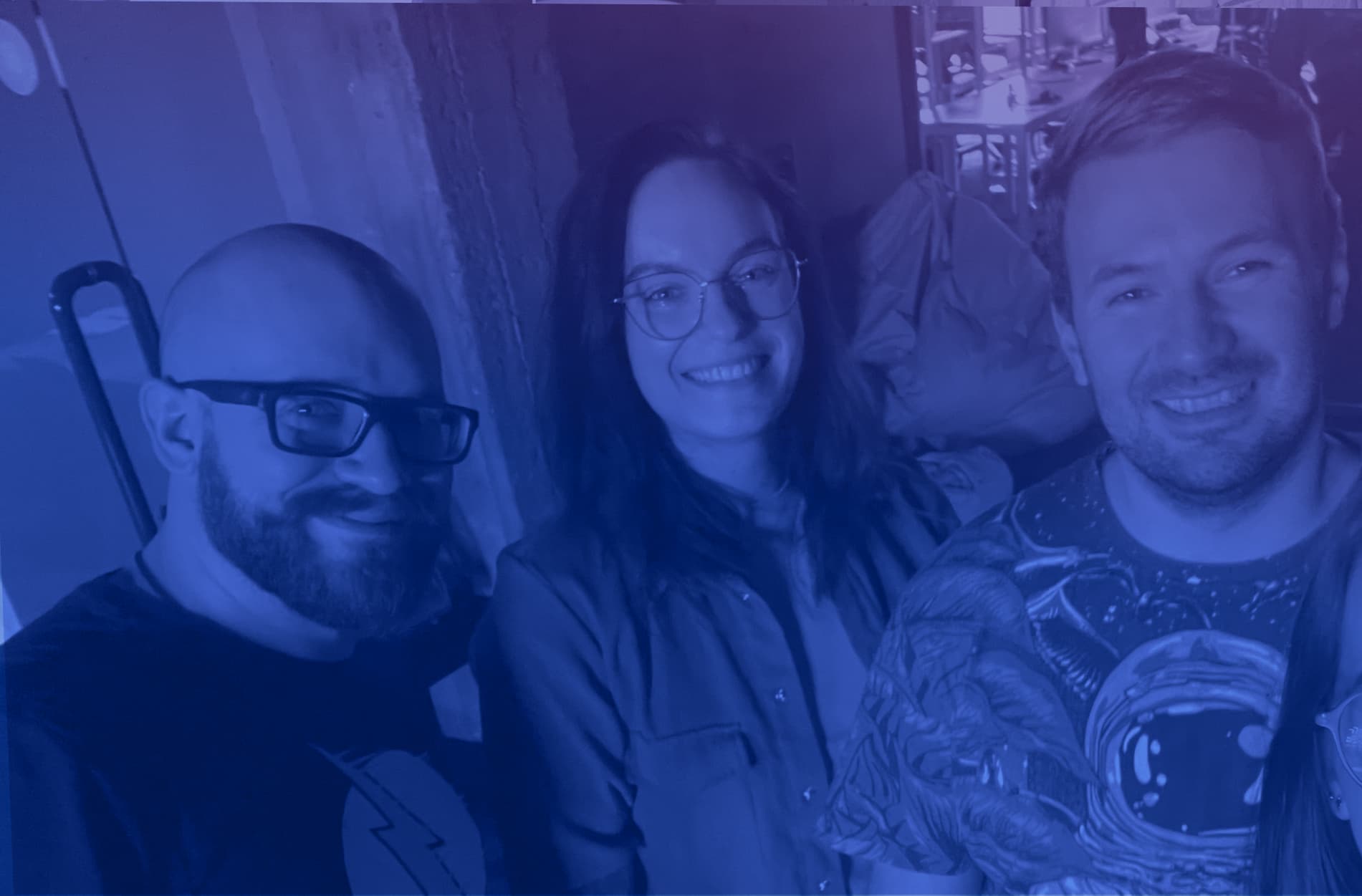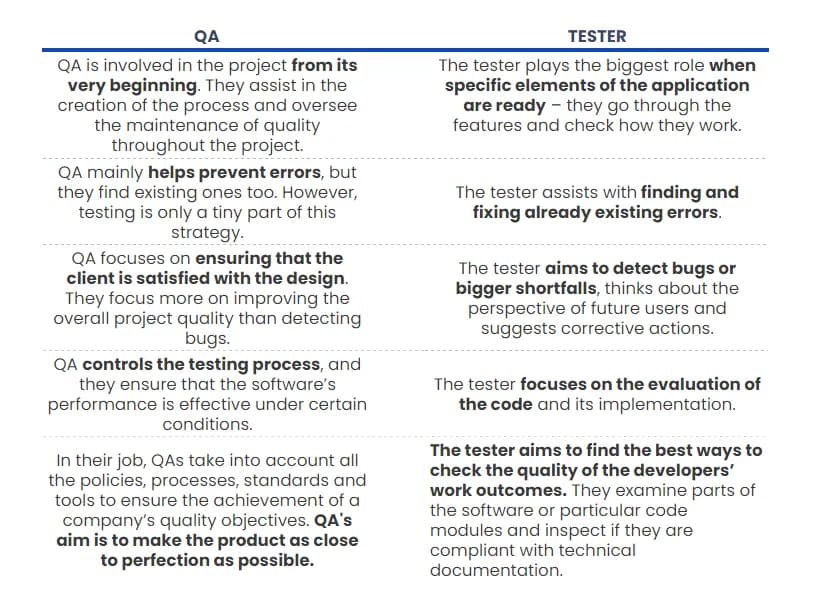
What is the role of a QA Engineer?
11 min read
Contents
While thinking about Quality Assurance, the first thing that probably comes to your mind is testing, and the association is absolutely correct. However, there is so much more about QA than just testing. We’ll explore the potential of QA Engineers in this article.
Who is QA, and what do they do?
In the software development team, apart from project leaders, software developers and QA Engineers play a very important role.
A Quality Assurance (QA) Engineer is responsible for ensuring the quality and reliability of software or products through systematic testing and verification processes. The main goal of a QA Engineer is to contribute to the delivery of high-quality products or software by systematically validating and verifying that they meet specified requirements and standards.
Taking an active role in the development of a project, QA advises on what can be improved or simplified, looking at the results from the perspective of the end-user of the software, and educates the team on the process of application development.
QA is a safety guardian who often has to ask the client and the team uncomfortable questions at the beginning of the process. They do it to define expectations for the final product accurately and ensure that these expectations are met during the software development process. QA helps collect system requirements specifications (SRS) and asks questions about inaccuracies in a series of meetings to clarify the application picture from general to specific.
Take notice
QA ensures the quality of the project during development but is not the only person responsible for the quality of the delivered product. The responsibility lies with all team members.
At the start of a project, the QA helps define the deployment process, the environments and the way of gathering customer requirements so this knowledge can then be applied to quality testing.
QA vs the Project Leader
The QA Engineer is very often the right hand of the Project Leader. However, they focus more on the technical requirements in the context of subsequent application testing and deployment than on controlling individual tasks and coordinating the team.
QA can be described as an 'information hub' for the team and the customer. They’re an important source of knowledge for the client and the developers because they regularly use and test the application under development, so, from the practical perspective, they know it best of the whole team (they have more knowledge even than the Project Leader in this context). Hence, the QA very often answers questions from developers and customers about specific app features.
Read more about the role of the Project Leader at Revolve from our article.

The QA during the software development phase
During the software development phase, the QA's role is strongly operational. As the person with the broadest technical knowledge of the project, the QA tests the app against the customer's requirements and asks the developers questions from the perspective of the app user, focusing on the user's convenience. In simple words, they combine gathering requirements with testing.
The goal of QA in a project is to ensure uninterrupted development.
What else does QA do in a project?
Provides developers with information about the potential risks of releasing the software as it is at the time of testing.
At the end of each sprint, they take care of a regression (regression is testing existing features to ensure new changes haven't affected existing functionalities), which is a short process of testing the application and going through all its functionalities one by one.
Hunts for bugs and gives the team suggestions for fixing them.
Important
QA doesn’t decide whether the software is 'good' or 'bad' and isn’t responsible for the final version. At Revolve, our customers decide whether a particular version of the software is, in their opinion, ready for release or needs further bug fixes. However, it’s the QA who provides information about the software that helps make the best decision.
What is the difference between a tester and QA?
QA and Software Tester are critical parts of project quality management that complement each other, but they aren’t synonymous positions. Then, what’s the difference?

So can QA be called a software tester? Well, it mainly depends on the clients and their communication. At Revolve, QAs and testers do the same work.
QA as a guardian of medical software security
The role of Quality Assurance Engineer is crucial in medical software development due to the unique nature of healthcare applications. QA ensures that the software meets specific requirements and standards.
How do they do this? Let’s see.
In healthcare software, errors can have serious consequences. QA ensures that the software functions reliably and accurately, minimising the risks for patients.
QA also verifies if the patient data is secure and compliant with regulations to protect patient privacy according to GDPR.
QA ensures the software has an intuitive and user-friendly interface, allowing medical staff and patients to navigate the application easily and perform their tasks efficiently.
QA cares for the interoperability of the software. During testing, they ensure the app is compatible with various devices, operating systems, and browsers, facilitating seamless information exchange.
QA engineers help keep medical software running smoothly. They regularly test and update the software to fix problems, adjust to changes in healthcare, and add new technology.
QA processes involve detailed documentation and tracking. This is important for audits, meeting regulatory requirements, and keeping a complete record of the software development and testing journey.
QA engineers work with healthcare professionals to confirm that the software meets clinical needs and adds value in real medical situations. This confirmation guarantees that the software matches its intended clinical purpose and goals.

How does QA test the software?
The Quality Assurance Engineer in the project takes care of the Quality Control (QC). QC aims to find errors in the app by testing it with various methods. The more types of tests used, the better chance of finding all issues.
Quality Control (QC) is a process that ensures products or services meet specified standards and customer’s expectations.
QAs take into account the user’s recommendations and write tests to make sure that the product meets their expectations. Testing is crucial in QC because it finds and fixes faults in the product, helping to maintain the quality throughout the development cycle.
QAs perform manual tests, using special testing tools or automated tests – the programs that execute pre-designed test cases.
The main types of tests the QA perform during the project:
Integration Test: a test in which software modules (e.g., API, database) are integrated logically and tested as a group. The purpose of this level of testing is to expose bugs in the interaction between these software modules.
System Tests (End-to-End Testing): a type of testing that aims to evaluate the end-to-end system specifications from user's perspective.
System Integration Testing (SIT): an optional type of testing that involves the overall testing of a complete system of many subsystem components or elements. The system under test may be composed of hardware, software, hardware with embedded software, or hardware/software with human-in-the-loop testing.
Feature Tests: a type of testing where only a specific functionality or a fixed bug is tested to check whether the functionality works fine and see if there are other issues due to the changes in the related components. Feature testing is the main part of the QA Engineer's work during the development phase and is part of the development process. It utilises both black-box and grey-box techniques.
Regression Tests: a type of software testing that confirms that a recent program or code change has not adversely affected existing features. They are a full or partial selection of already executed test cases that are re-executed to ensure that existing functionalities work fine.
Quality Assurance Engineers also check whether the software meets the safety and regulatory compliance criteria, as well as its general performance and responsiveness.
Good to know
QA usually starts writing tests after the first demo when the core of the application is stabilised enough and doesn’t change from sprint to sprint. Then, they gradually add tests to the elements of the application.
Quality in medical projects: ISO standards
The QA Engineer's task is to ensure quality throughout the manufacturing process and to make sure that the software complies with internal processes and ISO 13485. To achieve this, the QA, together with the regulatory specialist, prepares detailed documentation that proves that the project is being carried out in accordance with Quality Management Systems (QMS).
Quality Management Systems (QMS): processes and procedures implemented by medical device manufacturers to ensure consistent quality across product development, manufacturing, and distribution. QMS includes documentation, risk management, monitoring, and continuous improvement to ensure medical device compliance, safety, and efficacy.
QA also ensures that in both software testing and regulatory matters, all activities are of a high standard.
Why MDR projects require QA engineers in projects
The projects dedicated to medical applications and compliant with medical regulations (MDR) differ from the “usual” project.
What’s the main difference?
Working on a medical project primarily involves following specific regulations. There is much more emphasis on documenting every step of testing and meticulously performing regression testing. When working on such a project, the QA Engineer can’t ignore even minor errors.
In the case of software developed under MDR, every bug that occurs should be subjected to a risk analysis because it is, after all, about health. Therefore, QA, developers, and regulatory specialists have more work to do, and quality control is performed more extensively.
The regulatory area, which has a huge impact on the quality of the entire project, requires additional competencies from the QA, knowledge of company processes as well as medical standards and regulations. The whole process is, of course, overseen by a dedicated regulatory specialist, but the entire project team should be familiar with the basic quality assurance processes and the specific guidelines needed to implement them.

QA vs wellness app and Class I, II and III apps
The scope of QA’s work can vary significantly based on the developed product or application type. Let's compare their responsibilities while working on wellness apps, and apps that fall into Class I, II, and III.
Wellness apps are generally not classified as medical devices and may not be subject to specific medical device regulations. However, they might need to comply with data protection and privacy regulations.
QA ensures that the app functions as intended, providing accurate and reliable information or services related to wellness. They evaluate the UI and UX to ensure ease of use and accessibility, as well as address data security concerns, especially if the app handles personal health information.
Class I devices are considered low-risk and may not require regulatory clearance or approval, but they still need to comply with general controls.
QA implements and documents design controls to ensure the device meets specified requirements. They identify and mitigate potential risks associated with the device, maintain proper documentation throughout the product development lifecycle and perform testing to verify and validate that the device meets design inputs and requirements.
Class II and Class III devices are moderate-risk and high-risk devices, and they require conformity assessment procedures, including a Notified Body's involvement, under the Medical Device Regulation in the EU.
QA implements and documents design controls in greater detail compared to Class I devices. They provide evidence helpful in future clinical trials to demonstrate the safety and performance of the device. They also establish processes for monitoring and reporting the performance of the device once it is on the market and ensure that the labelling and instructions for use meet regulatory requirements.
Benefits of having QA on the project
Having a Quality Assurance Engineer in a project is crucial for various reasons.
Let’s have a look at some of them:
QA engineers know the product even better than the founders or users. They often possess in-depth knowledge of the application they are testing and know how to use all its features.
QA engineers collaborate closely with developers from the project's inception, fostering a comprehensive understanding of the application's intended purpose and functionality among the team.
QA is a guarantee of quality to the client. QA oversees the entire software development process – from start to finish. In this way, they are able to spot errors on the fly, which protects the client from wasting time and money.
QA is the “eyes” of the user. QA engineers immerse themselves in the users' perspective, aiming to understand how different users may interact with the application and identify aspects critical for a positive user experience.
What does the role of a QA look like at Revolve?
The work of QA at Revolve can be summed up as meeting the same person in different roles and continuously expanding their competencies.
Our QAs are increasingly extending their skills not only in the area of manual testing tools but also in other areas, such as application performance testing.
As mentioned before, they closely collaborate with the Project Leaders and communicate with the team and the client about technical requirements, application features and current testing results.
QA at Revolve has additional competencies in the regulatory area. Knowledge of company processes, standards, and regulations is a key aspect of testing work.
QA also plays the role of a business analyst. They are the ones who approach requirements gathering in detail and anticipate all possible actions of the application, as well as the user's interactions with the application. They also understand the business needs and objectives, collaborating closely with the clients to elicit the requirements, ensuring that the software solution aligns with the goals.
The voice of our QA Engineers
We’ve asked our QA Engineers, Marta, Paweł, and Michał, about their daily work, challenges and favourite aspects of their positions. Here’s what they said.
As QA, I focus on maintaining the quality of the software we develop by analysing requirements, running tests, reporting bugs and creating the necessary documentation. At the same time, I ensure that the quality of its production process is maintained, working closely with the whole team. A frequent challenge in my job is to cover the software with tests as well as possible in the face of changing requirements. My greatest satisfaction comes from using my soft skills in the technical world (perception, communication).
My role within the company is quite specific, as I have a more consultative and mentoring role. My main responsibility is to help and advise others and improve processes, which impacts the overall quality of the solutions we deliver. The biggest challenge in my job is communicating the bugs I find. This is one of the most important things in any tester's job, but as a fan of a holistic approach to quality, I definitely prefer preventing bugs more than finding them later. The best part of my job is definitely helping others. I'm glad when I can help solve someone's problem. I also get a lot of satisfaction from tracking down particularly troublesome bugs – it's a kind of detective work.
My responsibilities as a QA involve following the process, verifying the correct implementation of business assumptions, running tests, reporting defects, and maintaining documentation. The biggest challenge in my job is staying focused and thinking outside the box. My greatest satisfaction comes from finding a bug after a long testing of an area with the initial thought, 'what could have gone wrong there'.
Let us know how does the role of a Quality Assurance Engineer functions in your company!



